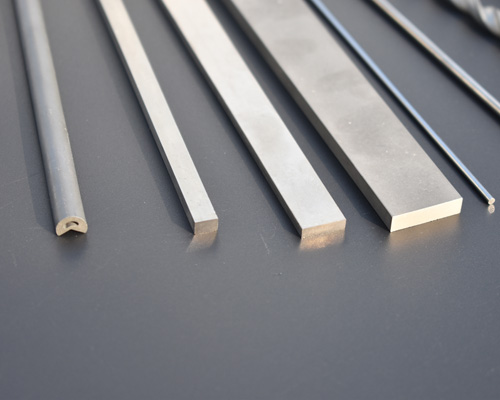Tungsten carbide strip is a highly versatile and durable material that finds widespread use in various industries, such as metalworking, woodworking, and mining. Known for its exceptional hardness and wear resistance, tungsten carbide strip is a preferred choice for cutting tools, wear parts, and other high-performance applications. In this blog post, we will explore how tungsten carbide strip is manufactured and discuss its key properties. As a leading manufacturer of tungsten carbide products, Diatooling is committed to delivering high-quality and reliable solutions to meet the needs of different industries.
1.Introduction to Tungsten Carbide Strip
https://www.diatooling.com/cemented-carbide-strip.html is a composite material composed of tungsten carbide particles bonded together by a metallic binder, typically cobalt or nickel. Tungsten carbide, with its exceptional hardness and high melting point, provides the strip with excellent wear resistance and strength. The metallic binder, on the other hand, helps to maintain the integrity of the strip and enhance its toughness.

2.Powder Metallurgy Process
The manufacturing process of tungsten carbide strip involves a technique known as powder metallurgy. This process consists of the following steps:
a. Powder Preparation: Tungsten carbide powder and metallic binder powder are mixed in precise proportions, typically ranging from 85-95% tungsten carbide and 5-15% metallic binder. The powders are thoroughly blended to ensure a homogeneous mixture.
b. Compaction: The blended powders are then compacted under high pressure to form a green compact. This compact is a preform of the desired shape and dimensions of the final tungsten carbide strip.
c. Pre-Sintering: The green compact is subjected to a pre-sintering process, also known as debinding, to remove the organic binders used in the compacting process. This step is essential to prevent any undesirable chemical reactions during the final sintering process.
d. Sintering: The pre-sintered green compact is placed in a high-temperature furnace and subjected to a sintering process. Sintering involves heating the compact to temperatures close to the melting point of the metallic binder. During this process, the metallic binder melts and bonds the tungsten carbide particles together, forming a dense and solid tungsten carbide strip.
e. Finishing: The sintered strip is then subjected to various finishing processes, such as grinding, polishing, and coating, to achieve the desired dimensions, surface finish, and performance characteristics.
3.Key Properties of Tungsten Carbide Strip
Tungsten carbide strip exhibits several key properties that make it highly sought after in various applications:
a. Hardness: Tungsten carbide strip is renowned for its exceptional hardness, ranking just below diamond on the Mohs hardness scale. This hardness allows the strip to resist wear, abrasion, and deformation, ensuring a longer tool life and enhanced performance.
b. Wear Resistance: The combination of tungsten carbide particles and the metallic binder results in a material that is highly resistant to wear. Tungsten carbide strip can withstand the most demanding cutting, shearing, and abrasive operations, making it an ideal choice for cutting tools and wear parts.
c. Strength and Toughness: Despite its hardness, tungsten carbide strip also possesses good strength and toughness. The metallic binder provides the strip with the necessary toughness to withstand impact and shock loads, reducing the risk of breakage and failure.
d. Heat Resistance: Tungsten carbide strip can withstand high temperatures without losing its hardness and strength. This heat resistance is crucial in applications where the strip is exposed to high temperatures during cutting or machining processes.
e. Chemical Stability: Tungsten carbide strip is highly resistant to chemical attack, making it suitable for use in corrosive environments. It can withstand exposure to acids, alkalis, and other harsh chemicals without undergoing significant degradation.

4.Diatooling: Your Trusted Provider of Tungsten Carbide Strip
As a leading manufacturer of tungsten carbide products, Diatooling specializes in producing high-quality tungsten carbide strip that meets the specific needs of different industries. With years of experience and a dedication to excellence, Diatooling ensures that their tungsten carbide strip is manufactured using the finest materials and state-of-the-art processes.
Diatooling's tungsten carbide strip exhibits the exceptional hardness, wear resistance, strength, and toughness that make it ideal for cutting tools, wear parts, and other high-performance applications. The company's commitment to quality and customer satisfaction is reflected in their rigorous quality control measures and continuous improvement efforts.
Conclusion
Tungsten carbide strip is a versatile and durable material that is widely used in various industries. Manufactured through the powder metallurgy process, tungsten carbide strip exhibits exceptional hardness, wear resistance, strength, toughness, heat resistance, and chemical stability. These properties make it an ideal choice for cutting tools,wear parts, and other demanding applications. As a trusted provider of tungsten carbide products, Diatooling ensures that their tungsten carbide strip is manufactured to the highest standards, delivering reliable and high-performance solutions to meet the needs of different industries. Contact Diatooling today to discover their range of tungsten carbide strip and experience the benefits of this exceptional material in your applications.









Comments (0)